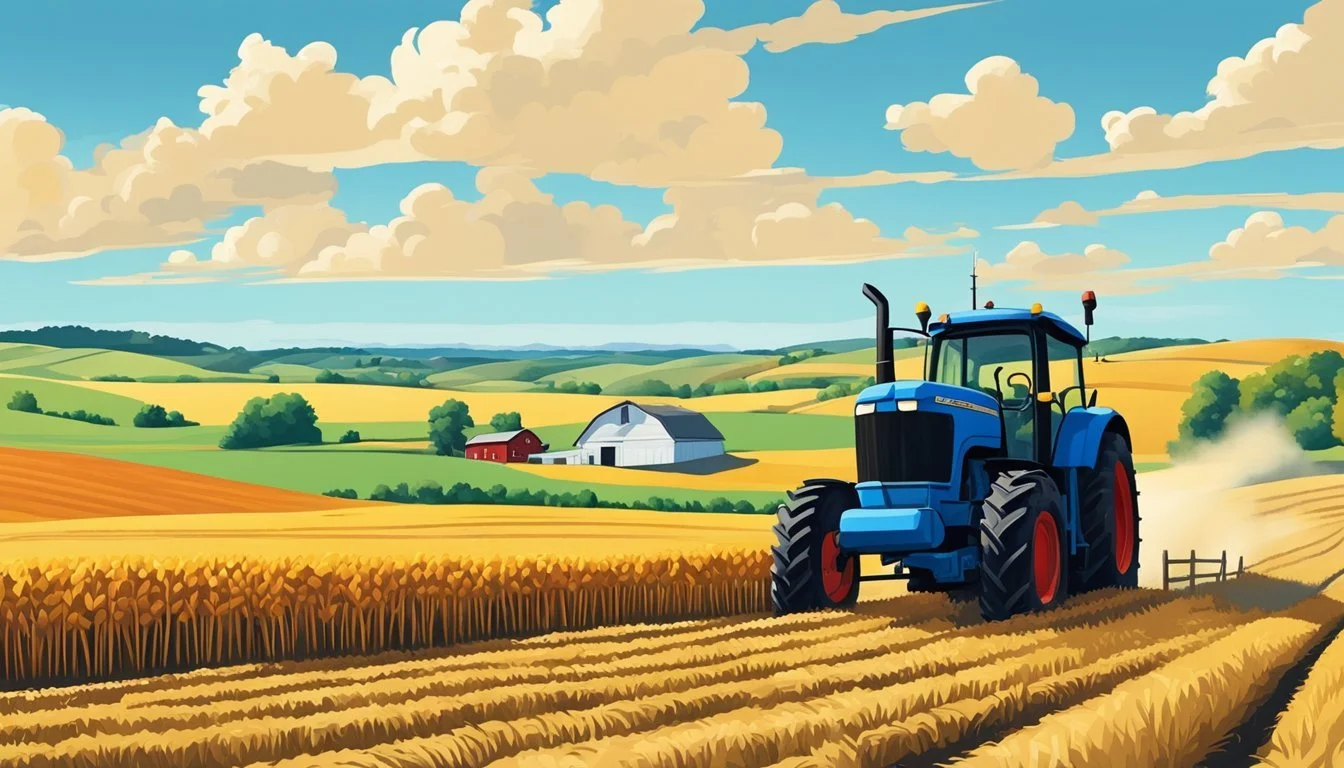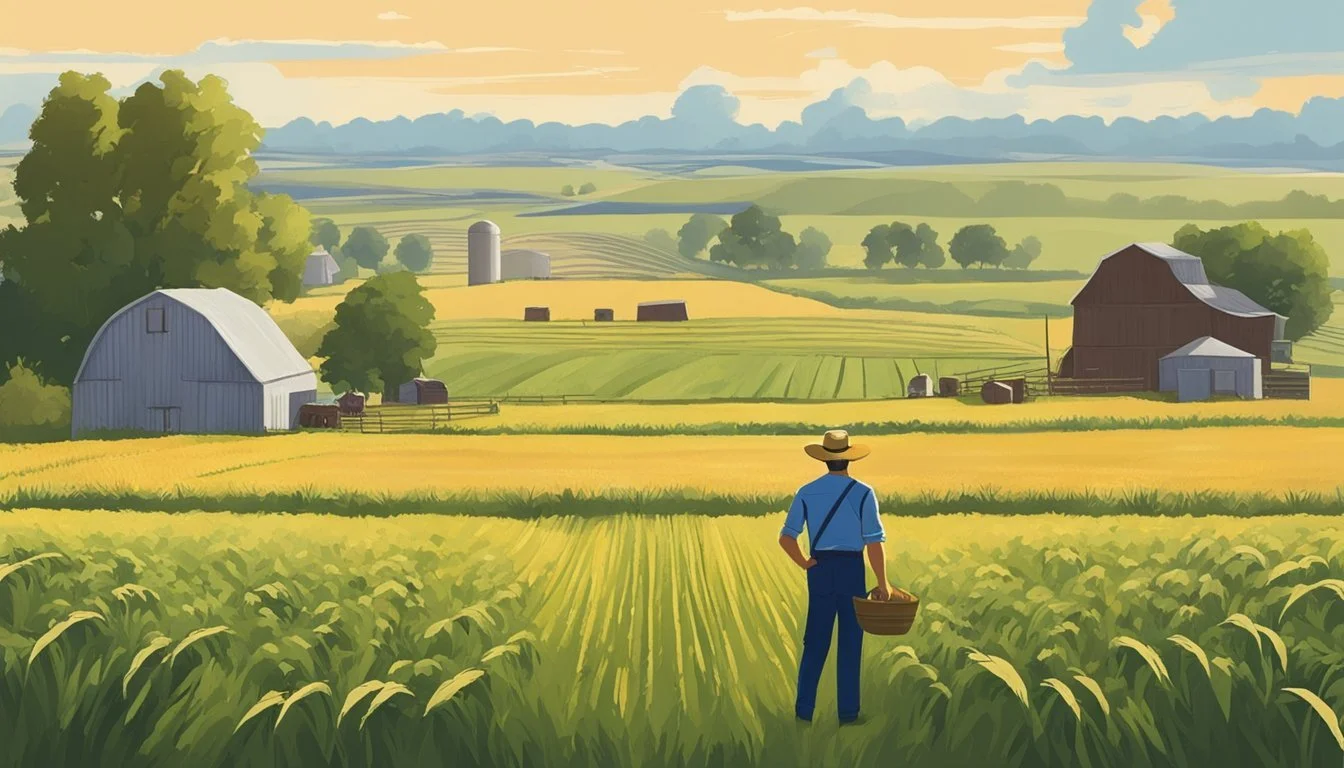Right to Farm Law in Kansas
Understanding Agricultural Protections
The Right to Farm Law in Kansas serves as a legal framework designed to shield agricultural operations from nuisance lawsuits. It was enacted in 1982, as a proactive measure to preserve farmland and support farming activities within the state. Over the years, this legislation has retained its importance due to the evolving landscape of rural Kansas, which has seen a significant reduction in the number of farms and the total area of farmland.
In legal terms, the statutes that constitute Kansas's Right to Farm Law are found in Kan. Stat. Ann. §§ 2-3201 to 2-3205. These laws offer protection to farmers and ranchers by allowing agricultural activities to continue despite the challenges posed by suburban expansion and the complaints that often arise from new residents unaccustomed to the realities of agricultural life. The law's intent is to sustain the viability of the agricultural sector by providing farmers with a degree of certainty and protection.
Legal resources and court rulings have further interpreted and refined the scope of the Right to Farm Law in Kansas. The outcomes of these judicial proceedings have provided clarity on issues such as property rights, road ditch rights-of-way, and the balance between private interests and agricultural practices. The state's legal apparatus, including opinions delivered by the Kansas Court of Appeals, helps navigate the complexities of these laws, ensuring they are applied fairly and effectively in protecting the state’s agricultural heritage.
Background of Kansas Right-to-Farm Law
In Kansas, the Right-to-Farm Law stands as a significant legislative measure designed to protect agricultural operations. This section explores its foundation and the legal interpretations that shape its application.
Historical Context
Kansas implemented the Right-to-Farm Law in 1982, in response to the increasing urban encroachment on farmlands. The intent was to safeguard farmers from nuisance lawsuits that could arise when non-farming residents moved into rural areas traditionally used for agricultural purposes. Despite the law's protection, Kansas has seen a reduction in farm numbers and farmland acreage.
National Agricultural Law Center Overview
The National Agricultural Law Center provides a comprehensive outline of Kansas's Right-to-Farm statutes codified in Kan. Stat. Ann. §§ 2-3201 to 2-3205. The statutes detail the legal framework established to protect existing agricultural practices and farmland from nuisance claims, thereby supporting the state's agricultural heritage and economy. Legal insights and interpretations regarding these statutes are further explored in various publications, including those by Roger A. McEowen on the Agricultural Law and Taxation Blog.
Legal Framework
In Kansas, the agricultural sector is governed by a robust legal framework designed to protect farming activities. This framework comprises a blend of federal, state, and local regulations, as well as a distinction between common law and statutory law.
Federal, State, and Local Regulations
Right-to-Farm Laws in Kansas are primarily state-regulated, with the Kansas Statutes Annotated §§ 2-3201 to 2-3205 serving as the backbone. These laws are designed to safeguard farmland and agricultural activities from nuisance lawsuits, thereby helping to preserve the agricultural landscape of the state.
Federal laws intersect with Kansas's agricultural law primarily in terms of compliance with nationwide environmental and labor regulations. Local laws may also play a role in specific zoning requirements or restrictions, though the State Laws tend to preempt local ordinances in order to provide a consistent legal environment for farmers.
Common Law vs Statutory Law
Kansas's approach to agricultural protection has transitioned from reliance on Common Law—a body of unwritten laws based on legal precedents—to more definitive Statutory Language crafted and enacted by legislation.
Common Law: Traditionally handled disputes through general principles and past judicial decisions. This included cases of trespass and nuisance, which could significantly impact farming operations.
Statutory Law: The clear statutes within Kansas’s Right-to-Farm laws offer concrete definitions and protections, aiming to limit the unpredictability of common law outcomes. This shift to a statutory approach provides farmers with more predictable and consistent legal expectations.
Scope and Provisions
The Right to Farm laws in Kansas are designed to protect agricultural activities by setting clear boundaries on what is permissible for farms and agricultural operations. These laws are critical in maintaining the balance between farming activities and the interests of the wider community.
Protected Activities and Enterprises
Kansas Right to Farm Statutes provide robust protection to a range of agricultural activities. They ensure that farms are permitted to operate without the undue interference that might stem from nuisance claims. These protections extend to cover the production and processing of agricultural commodities.
Specifically, Statute 2-3201 lays out the framework, stating the intent to safeguard farmland and agricultural operations, promoting the importance of agriculture to the economy of Kansas. Good Agricultural Practices (GAPs) are encouraged as standards for production and are implicitly protected under the right-to-farm provisions to ensure both public health and the reliable production of agricultural commodities.
Limits and Exceptions
Despite the wide-ranging protections, there are limitations and exceptions in place to prevent the abuse of these laws. These include:
Restrictions on operations considered to be a public health hazard.
Cases where farming operations have a direct negative impact on the health and well-being of the community.
Situations where farms are established after residential developments, which may not enjoy the same level of protection.
It's critical to note that while the Right to Farm laws offer a significant level of protection, they are not absolute. The statutes contemplate changes in operation and stipulate compliance with other relevant laws. Therefore, while agricultural operations are defended, they must also coexist responsibly with the requirements for public health and safety.
Legal Protections for Farmers
Legal protections under Kansas Right-to-Farm laws provide a robust defense for farmers and ranchers against nuisance claims, reinforcing the agricultural heritage of the state.
Nuisance Claims Defense
In Kansas, Right-to-Farm laws serve as a shield for qualifying farmers and ranchers against nuisance lawsuits. These laws recognize that agricultural activities, when performed consistently with good agricultural practice and established prior to surrounding non-agricultural developments, should not be deemed a nuisance. In essence, these statutes protect existing agricultural operations by preventing newcomers from filing nuisance claims that could threaten the viability of farming activities.
Nuisance Claim - A legal complaint brought by an individual who alleges that their enjoyment of property is being hindered by the actions of another, in this case, agricultural operations.
Nuisance Lawsuits - Legal actions initiated against farmers or ranchers based on the premise that normal farming operations are creating a nuisance.
Farmers benefit from this defense when they can demonstrate adherence to good farming practices and that their farm predated any conflicting land use changes in the area.
Coming to the Nuisance Doctrine
The "Coming to the Nuisance" doctrine is a critical component of Kansas's Right-to-Farm law. This principle is based on the idea that individuals who move to an area with an established agricultural operation cannot claim a nuisance against this pre-existing condition of the land. The law inherently acknowledges the priority of existing farms and ranches over new land developments in close proximity to agricultural land.
Coming-to-the-Nuisance - A legal concept that prevents someone from winning a nuisance claim against an established operation if the claimant moved to the location of the nuisance after the operation was already in place.
This aspect of the law provides long-term certainty to farmers and protects their ability to conduct standard agricultural activities without the threat of legal action by new residents or commercial developments unfamiliar with the realities of agricultural life.
Implications for Land Use
The Right to Farm Law in Kansas has significant implications for the use and regulation of rural farmland, affecting how landowners may leverage property rights and zoning regulations. It intertwines with conservation efforts, shaping the interaction between agricultural practices and long-term land conservation strategies.
Zoning and Landowner Rights
Kansas Right to Farm Law upholds that farmers have the right to engage in agricultural activities on their land, thereby influencing zoning policies in rural areas. Landowners may find that local zoning regulations are supportive of farming practices, even when neighboring properties transition to non-agricultural uses. With this legal backing, farmland is protected from ordinances that could otherwise restrict agricultural uses. It ensures that agriculture remains a permitted land use, vital for preserving the rural character and economy of a site.
Conservation Easements and Property Rights
Conservation easements in Kansas operate as a voluntary legal agreement that permanently limits uses of the land to protect its conservation values. When landowners enter into conservation easements, they retain property rights and can continue to own and use their land, including for agriculture, while preventing future development that could be detrimental to the environment. Such easements balance property rights with the need for land conservation in agricultural areas, allowing for sustainable farming that aligns with long-term environmental goals.
Economic and Environmental Considerations
The Right to Farm Law in Kansas has significant influence on both the economy and the environment, impacting the valuation of agricultural land and raising considerations about environmental effects and public health.
Value of Agricultural Land
The economic landscape for Kansas farmers is shaped by the prevailing fair market value of agricultural property. Market value can be affected by a myriad of factors, including legislative changes like the Right to Farm Law. Historically, states with Right to Farm Laws have aimed to protect agricultural land from nuisance lawsuits and urban encroachment, theoretically maintaining higher land values for farming purposes. In Kansas, this protection suggests a stabilization of land value, by signaling to potential buyers the state's commitment to preserve farmland use over other types of development.
Aspect Description Cattle Feedlot Operations Contribute significantly to the economy but can affect land values adjacent to them due to odor and other factors. Agricultural Priority Right to Farm laws support agriculture as the preferred land use in farming zones, potentially keeping land values more stable for farmers.
Environmental Impact and Public Health
The environmental implications of farming activities are multifaceted, extending to public health and safety, particularly in the context of large-scale operations such as cattle feedlots. Kansas's Right to Farm Law underscores a complex relationship between agricultural practices and environmental health.
Odor: One of the most common issues associated with cattle feedlots is odor, which can affect the quality of life for nearby residents and raise public health concerns.
Environmental Impact: Agriculture has inherent environmental impacts, such as the runoff of nutrients and waste that can affect water quality. Environmental stewardship and public health measures are critical to balance the benefits of agricultural productivity with the need to protect the environment and public health.
It is in the intersection of these economic and environmental considerations that policymakers and stakeholders must work to find a balance that maintains Kansas's agricultural heritage while ensuring the sustainability of its natural resources.
Dispute Resolution
In Kansas, dispute resolution in right-to-farm conflicts involves specific measures for mitigation and legal interpretation by courts based on enacted ordinances.
Mitigation and Measures
Dispute resolution in Kansas typically begins with efforts to mitigate issues between agricultural producers and affected parties. The goal is to address concerns such as environmental impact, noise, and odors without escalating the situation. Mitigation strategies may include:
Best Management Practices (BMPs): Farmers are encouraged to adopt BMPs to minimize nuisances.
Mediation: Parties may utilize this process to resolve disputes amicably.
Mitigation focuses not only on resolving current conflicts but also on preventing future issues. Measures taken are aimed to minimize the need for legal intervention, thereby reducing potential costs associated with punitive damages and repairs.
Role of Courts and Ordinances
When disputes escalate, the Kansas courts interpret and apply right-to-farm laws, often considering local ordinances established by counties. Judicial decisions are guided by the following considerations:
Interpretation of Statutes: Courts examine the scope of the right-to-farm statutes.
Assessment of Damages: When applicable, courts may determine the cost to repair damages.
The role of courts is crucial in defining the limits of farming operations and protecting lawful agricultural practices, with careful attention to the balance of interests between farmers and their neighbors. Ordinances at the county level can often provide a localized framework that courts take into account when resolving disputes.
Case Studies and Precedents
This section delves into the practical applications and legal interpretations of the Right to Farm Law in Kansas, examining significant case studies and comparing these statutes with those of other states.
Kansas Specific Details
In Kansas, the Right-to-Farm Law aims to shield agricultural activities from nuisance lawsuits. A notable case that reflects the application of this law occurred in Norton County, where the owner installed a pipeline in the road right-of-way to transport liquified hog waste for his cropland. This case highlighted intersections of property rights, public roadways, and the Kansas Right to Farm Act.
While county commissioners often play a role in the administration of county affairs, their influence on right-to-farm laws' implementation can be limited when state laws are robust and preempt local regulation.
Comparative Analysis of States
Kansas stands alongside states like Maryland, Arizona, Colorado, and Maine—each with its own variation of right-to-farm statutes. However, the degree of protection and the specific conditions under which these protections apply can differ significantly:
Maryland and Kansas both prioritize the protection of agricultural activities, but Maryland emphasizes the importance of agriculture to the economy and rural heritage.
Arizona's statute specifically outlines activities deemed as farming to preempt misunderstandings and lays out a clear definition for legal protections.
Colorado, similarly to Kansas, has had significant legal discussions concerning the rights of farmers, especially regarding neighbor disputes and public road use.
Maine strongly supports agriculture by limiting nuisance claims, but the interpretation of "public purpose" can influence legal outcomes.
Each state crafts its right-to-farm laws to balance agricultural interests with the rights of neighbors and communities, reflecting the unique agricultural profiles and policy priorities within the state.
Future Developments and Predictions
In the dynamic landscape of Kansas agriculture, pending legal decisions and technological advancements promise to shape the sector's trajectory. They play critical roles in resource management, safety protocols, and the enhancement of key features within the farming industry.
Potential Legal Changes
Legal frameworks in Kansas surrounding Right-to-Farm laws may see changes aimed at balancing the interests of traditional agriculture with the concerns of environmentalists and the non-farming public. Legislators could consider amending statutes to include provisions for resource conservation and stricter safety measures to benefit both farmers and their surrounding communities. Enhanced regulation on the storage and transportation of farm products might also emerge to align with contemporary standards.
Research publications and legal scholars may influence these legal adjustments by providing insights through studies, which could lead to informed decision-making. The browser as a tool for disseminating and accessing this data becomes crucial for farmers, policymakers, and law professionals.
Technology and Farming Innovation Impact
Technological advancements have the potential to significantly alter farming practices and efficiency. A prominent focus remains on the pipeline of innovations, including precision agriculture tools that ensure optimal resource usage and reduce wastage. The incorporation of these technologies aids in better storage and safety measures and enhances the features available for farm management.
With the ongoing shift towards sustainable practices, Kansas farmers may embrace renewable resources, harnessing wind and solar energy to power operations. Transportation methods might evolve as well, transitioning to more eco-friendly options which impacts both environmental and economic aspects of farming.
The continued investment in research publication databases will underpin these developments, ensuring that knowledge is readily available. As tech innovations are integrated into agricultural processes, farming in Kansas stands on the cusp of a transformation that balances tradition with progress.








